Greetings, dear readers! Allow me to introduce you to the world of innovative technology “speech to text from audio file”. This progressive tool has a profound impact on many aspects of our lives, from optimizing business processes to improving everyday tasks.
Have you ever wondered how quickly we’ve gone from spoken speech to visualizing it as text? In this review, we will delve together into the history of audio speech to text. Discoveries, technological breakthroughs, all this awaits you.
You will learn how this technology works. The concept of “transcribing audio into text” will become familiar to you. We will discuss its practical application and benefits.
Together we will examine how audio speech to text has transformed business processes. We will find out how this tool simplifies our everyday life.
How to choose the best programs for speech to text audio file? We will advise! Let’s take a look at the best online services and provide useful tips.
And of course, we will not forget to look into the future. What innovations are waiting for us in the field of audio speech to text? What do experts predict?
Prepare for an exciting journey. Let’s open up new horizons in speech to text from audio file !
Introduction to SpeechFlow, an online audio to text translation tool
Before we begin, I would like to introduce a software that has revolutionized the speech recognition industry: SpeechFlow.
SpeechFlow is an online speech to text from audio file program designed for organizations and individuals wishing to enhance their online work, teleconferences, customer service, and much more. With SpeechFlow, you can easily convert voice to text and effortlessly carry out speech recognition. SpeechFlow offers a number of incredible benefits, including:
- Multilingual transcription services: SpeechFlow supports transcription services in 14 languages. It’s important to note that our accuracy is higher than our peers in every language, not just English.
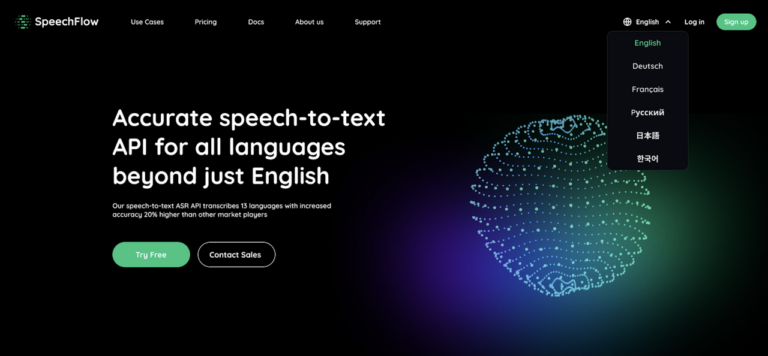
- Accurate and readable text: SpeechFlow’s AI model creates transcriptions that are easy to read and understand, with proper punctuation and optimized readability.
- Quick processing: SpeechFlow can process up to 1 hour of audio in less than 3 minutes, providing a fast and efficient solution for businesses and individuals. 5 hours of free trial: SpeechFlow offers a 5-hour free trial period, while many tools do not offer free trials or only offer them for a limited period.
- Cost-effective pricing: SpeechFlow uses a “pay-as-you-go” pricing model that is charged at just $0.0002 per second. It offers high-quality services at a lower cost, while providing users with full control and transparency over their usage and expenses.
If you’re looking for a voice-to-text converter, audio-to-text converter, or a speech recognition tool, SpeechFlow is your ideal choice.Try SpeechFlow today and make the task of speech to text from audio file easier.
Historical overview: The start of audio to text translation and its evolution
speech to text from audio file systems have become widely available due to a long history of developments and innovations. As pointed out by IEEE Spectrum, the first experiments in the field of speech recognition started as early as the 1950s[1]. But at that time, these were the simplest systems. They could only recognize individual words in a very limited context.
Progress in this area was linked to the development of digital technologies. From the 1970s, when machine learning began to be widely used in research, online audio speech to text became possible. According to an article in Nature, it was during this period that the foundations of many modern speech recognition methods were developed, including hidden Markov models and neural networks
By the 1990s, when computers became more accessible, speech recognition systems began to appear in commercial products. Users and organizations could apply these technologies in their work.
The early 2000s brought a new wave of development in the field of speech recognition. As Forbes claims, it was at this time that active work began on creating systems capable of understanding not just individual words, but entire phrases and sentences Today, speech to text audio file has become a powerful tool that is changing our lives. It has democratized access to information and facilitated communication. All of this has been made possible thanks to the efforts of researchers, engineers, and developers around the world.
In the future, this technology will continue to evolve. It will simplify our everyday life and work even more.
Technology basics: Understanding how audio to text translation works
Speech to text from audio file technology is based on a complex set of algorithms and machine learning models. Let’s delve into how it works in more detail.
The first stage is acoustic modeling. During this process, the audio signal is converted into digital form, creating a spectrogram—a visual representation of sound. The system then breaks this spectrogram into short, overlapping segments called frames. This helps the system recognize individual sounds, or phonemes, in speech.
The next stage is speech recognition. Here, a machine learning model, often referred to as the “acoustic model,” is used to match each frame to a specific phoneme. This is a complex process, as different people pronounce the same phonemes differently. Thanks to large volumes of training data, systems can cope with these diverse accents and speech styles.
The third stage is lexical modeling. This process links the recognized phonemes into words and phrases, using a “language model.” The language model understands the grammar and general context of the language, allowing it to predict which words are most likely to follow others.
The final stage is the output of the recognized text. At this stage, the system checks its predictions and corrects them if necessary to provide the most accurate and understandable text.
Understanding these basics will help you better understand how and why audio speech to text systems work the way they do. It will also help you make a more informed choice when selecting a speech to text audio file system for your business or personal needs.
Speech to text from audio file: Practical Applications and Advantages
The technology of audio speech to text, or decrypting speech to text audio file online, demonstrates significant progress. It not only transforms audio recordings into a textual format but also significantly improves work processes in various fields. Let’s examine in more detail the practical applications and advantages of this technology.
Education. In educational institutions, speech to text from audio file has become an integral part of the learning process. Teachers use it to transform audio lectures into text documents, facilitating the process of assimilating information for students.
Journalism. Journalists, especially those who conduct interviews, actively use speech to text from audio file. It helps them quickly transform recorded interviews into text articles.
Healthcare. In healthcare, speech to text from audio file also has a huge impact. Doctors and medical staff use this technology to translate voice notes into medical records, saving time and improving the accuracy of medical documentation.
Business. In the business sector, audio speech to text also shows its value. It is used for transcribing calls to customer service, creating text call reports, and analyzing customer feedback.
Law Enforcement. In law enforcement, online audio speech to text also plays an important role. Interrogation records and witness statements are transformed into text, assisting in case investigations and providing quicker problem resolution.
Marketing and PR. In the field of marketing and PR, speech to text audio file serves as a tool for extracting important information from audio and video content.
Podcasts and Radio. In the world of podcasts and radio, speech to text from audio file allows for the creation of text versions of audio content, enhancing its accessibility.
The main benefits of speech to text from audio file technology are efficiency, accuracy, and information accessibility. Storing audio recordings in text format significantly simplifies the search and analysis of information, allows for faster processing of large volumes of data, and makes content more accessible for people with hearing problems or those who prefer a text format.
Business Process Transformation with speech to text from audio file
The transformation of business processes through speech to text from audio file has become possible thanks to modern technologies. speech to text from audio file software, such as SpeechFlow, uses algorithms and machine learning to convert speech into a written format.
Accuracy and Speed. audio speech to text software allows for the processing of large volumes of data with high accuracy. This reduces the likelihood of errors, which is critical in business processes.
Automation. The use of audio speech to text software automates many processes that previously required human intervention. This frees up resources and allows for a focus on more important aspects of the business.
Data Analysis. Text data is easier to analyze than audio. Converting voice data into a text format allows companies to more easily identify trends and gather valuable information for decision-making.
Integration with Other Systems. Speech to text audio file software can be integrated with other business systems, creating more complex and automated workflows.
Increasing Accessibility. Speech to text audio file software makes content accessible for people with special needs, enhancing inclusivity and expanding the business’s audience.
Audio speech to text in Everyday Life
Audio speech to text technology is becoming increasingly important in everyday life, offering convenience and ease of use. It is easily accessible through a range of online services offering online speech to text from audio files.
The first thing that comes to mind is the possibility of voice input of notes and reminders. Many of us speak faster than we write. Thanks to this technology, you can easily record ideas and thoughts by voice, without worrying about having to transcribe them later.
For those studying foreign languages, online speech to text from audio file is a powerful tool. With it, you can listen to foreign language audio material while simultaneously seeing a text transcript, simplifying the process of understanding.
From a safety standpoint, using speech to text audio file while driving can be very useful. Instead of being distracted by typing text messages, you can simply speak them out loud, and the technology will translate them into text.
It’s also important to mention how crucial online speech to text audio file is for people with hearing impairments. Thanks to online audio speech to text, they have the opportunity to perceive audio content, which was previously unavailable.
In conclusion, it’s worth noting that reading text often happens faster and easier than listening to audio. This can be especially useful when viewing long lectures or webinars.
Thus, online audio speech to text technology plays a significant role in everyday life. Whether it’s learning, working, or communicating, it makes processes more efficient and accessible for everyone.
SpeechTexter
General Presentation: SpeechTexter is a free multilingual speech to text from audio file application that assists you with the transcription of notes, documents, books, reports, or blog posts using your voice. This app also includes a list of customizable voice commands, allowing users to add punctuation marks, frequently used phrases, and some in-app actions (undo, redo, create a new paragraph).
Architecture:
SpeechTexter uses Google’s speech recognition technology to convert speech into text in real time. This technology is supported by the Chrome browser (for desktop computers) and some browsers on Android OS. Other browsers have not yet implemented speech recognition.
Advantages:
- Powerful real-time speech recognition.
- Creation of text notes, emails, blog posts, reports, and more.
- Customizable voice commands.
- Support for over 70 languages.
Disadvantages:
- Does not support iPhone and iPad.
- Requires the use of the Chrome browser for full functionality.
Please note: no download, installation, or registration is required. Simply press the microphone button and start dictating.
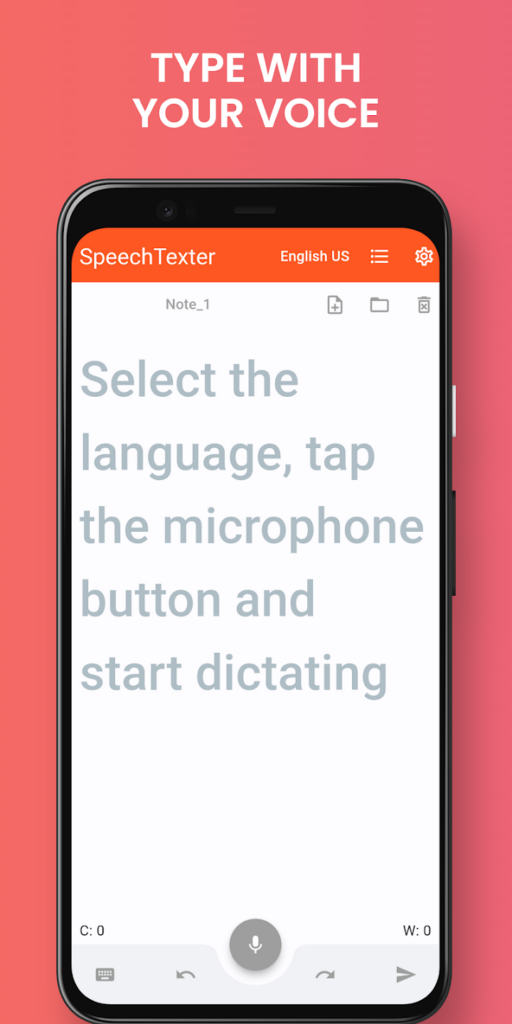
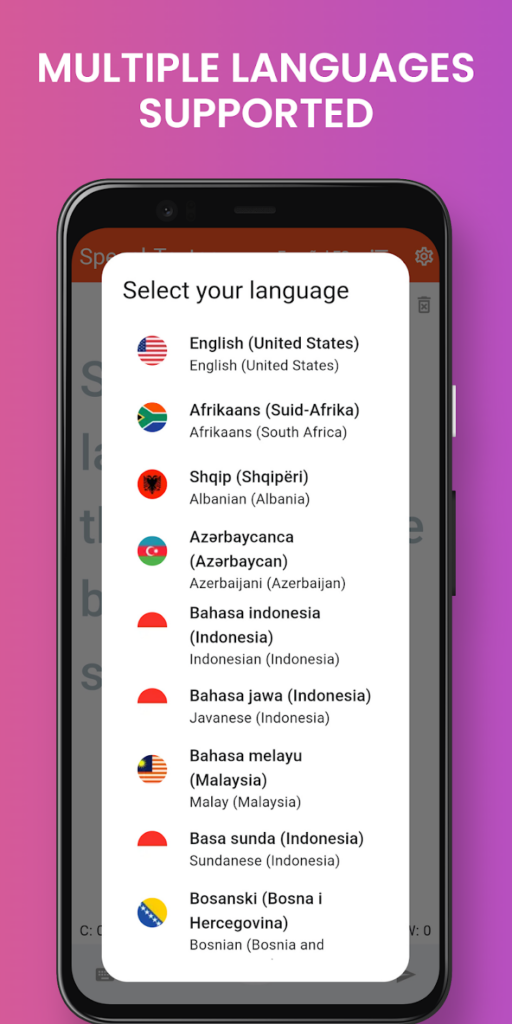
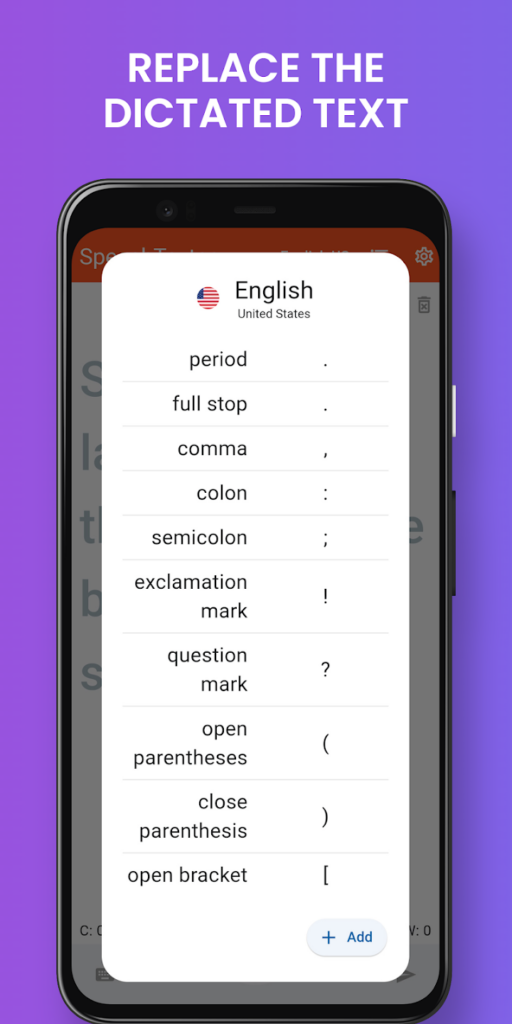
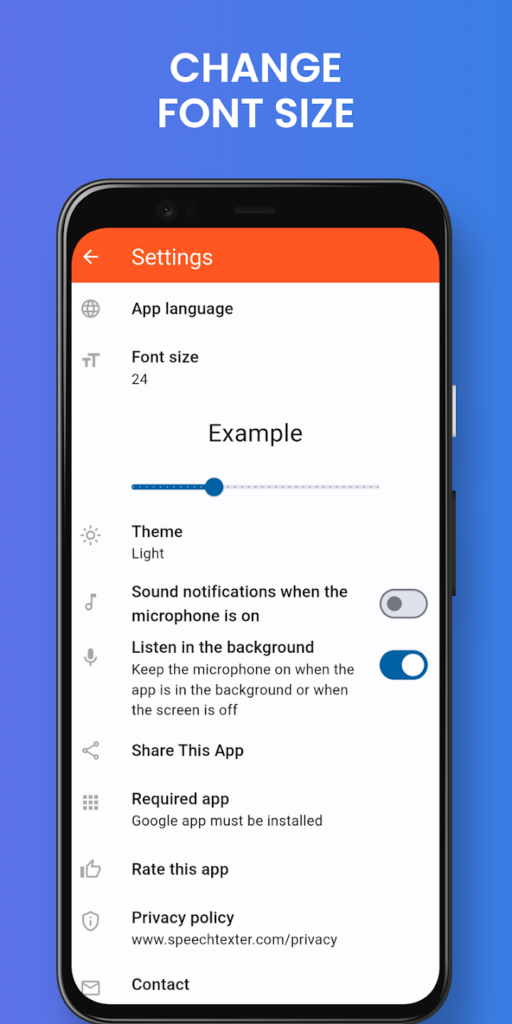
Temi
General Presentation:
Temi is a voice recording tool based on one of the most accurate speech recognition engines in the world. Temi offers the ability to broadcast speech to text from audio file in real time during recording! Store, search and extract useful information from transcripts synced with your audio (transcripts are provided for a small fee per minute).
Architecture: Temi provides high-quality voice recording and playback. It ensures automatic pause for incoming calls and automatic resume of recording if you close the app. Additionally, Temi allows you to import audio from other apps and rename recordings.
Advantages:
- Ad-free.
- Unlimited number of recordings.
- High quality recording and playback.
- Automatic pause for incoming calls.
- Ability to share recordings without limitations.
- Import audio from other apps.
Disadvantages:
- Currently, Temi only transcribes audio and video files in English.
- A fee is charged for transcripts depending on the length of the audio.
In conclusion, Temi is a powerful tool for those looking for a reliable solution for voice recording and obtaining transcripts with high accuracy.
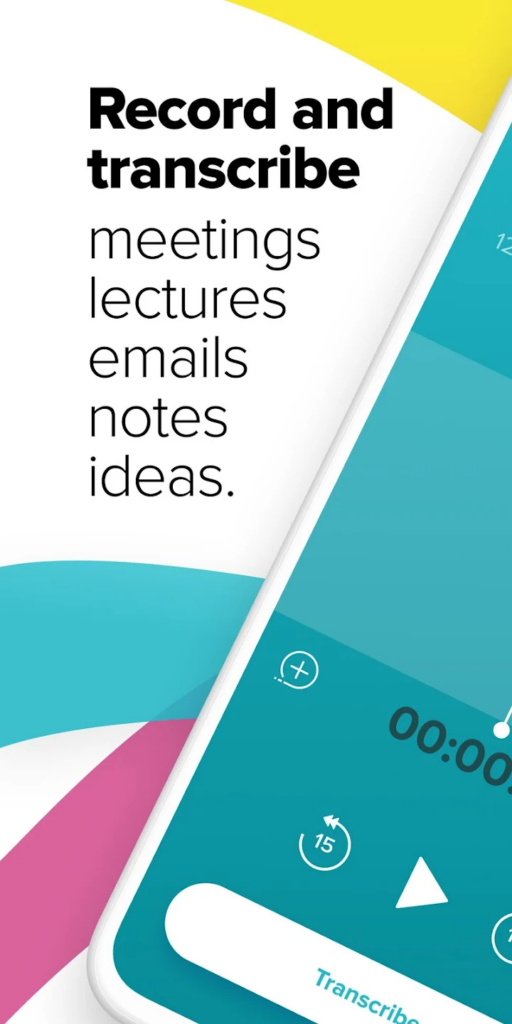
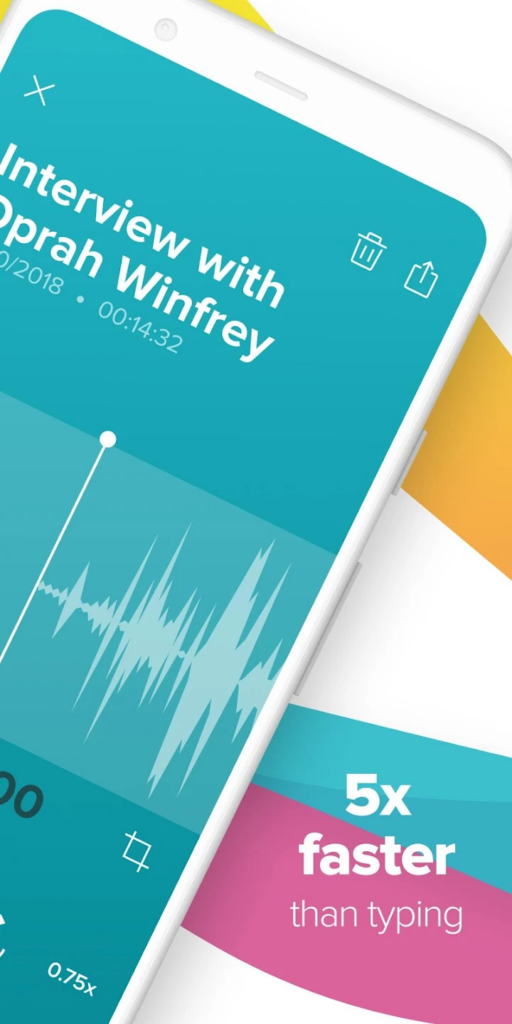

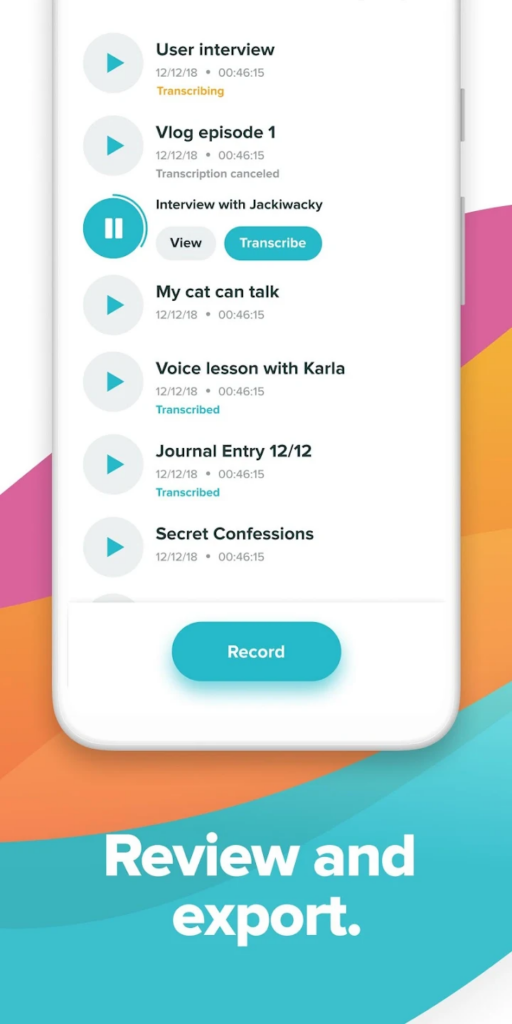
Transcribe Live
General Presentation:
“Transcribe Live” is a leading app in the field of “online speech to text from audio file” designed for professional use. It is used for instant transcription of meetings, interviews, notes, lectures, and conversations into text format, simplifying the process of documentation and data analysis. The use of speech recognition technologies allows for instant translation of audio recordings into text format.
Architecture:
With “Transcribe Live”, you can record audio in real-time and see your speech converted into text. The software was developed with user convenience in mind, so it allows for background mode operation with the screen off and provides time stamps for each spoken word.
Advantages:
“Transcribe Live” has several advantages, including:
- Instant transcription in several languages, including Arabic, English, French, Japanese, Korean, Chinese, Portuguese, and Spanish.
- Identification of different speakers in transcriptions in English, Spanish, and Japanese.
- Ability to quickly and easily share audio recordings and transcriptions with colleagues and friends.
- Respect for user privacy – data is stored only on your device and is not passed on to third parties.
Disadvantages:
Despite its variety of functionalities, “Transcribe Live” has some drawbacks:
- The app is only available to iPhone and iPad users; there are no versions for Android and PC.
- Subscriptions to “Transcribe Live” are renewed within 24 hours prior to the end of the current period, and the charge is deducted from your iTunes account.
“Transcribe Live” is an effective and reliable tool in the field of “online audio speech to text” that meets the needs of modern users and provides.
VoxRec
General Presentation:
VoxRec is a high-tech voice recorder (dictaphone) with a built-in speech to text from audio file service. This application is designed using artificial intelligence to convert your voice notes into text format.
Architecture:
VoxRec offers features for recording audio, live transcription, editing and formatting transcribed text, emailing transcriptions, customizing dictionaries, searching for keywords, and much more. It also supports recording and synchronization with Apple Watch, as well as seamless integration with cloud services.
Advantages:
- Instant Transcription: The app provides fast and accurate voice to text transcription in real time.
- High-Quality Recording: Supports recording on various devices and allows the selection of audio quality. Editing and Formatting: The ability to edit and format text right within the app.
- Cloud Integration: Automatic backup of all recordings and transcriptions in the user’s cloud service.
- Multilingual: Supports dictation and speech to text transcription in 27 languages.
Disadvantages:
- Platform Support: The app is only available for iPhone, iPad, and Apple Watch users; there are no versions for Android or PC.
- Transcription Quality: The quality of transcription may decrease in the presence of strong background noises.
- Lack of Automatic Punctuation: Automatic punctuation may not be available in all languages.
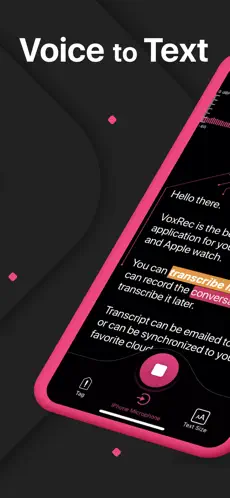
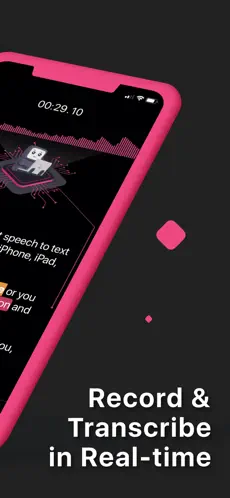
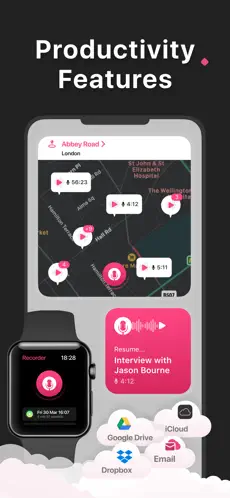
Transcribe – Speech to Text
General Presentation:
Transcribe is your personal assistant for transcribing video and voice notes into text. The application uses artificial intelligence technologies that allow you to instantly receive quality, readable transcriptions with just the press of a button.
Architecture:
Transcribe automatically transcribes any video or voice notes, supporting over 120 languages and dialects. You can import files from other applications and DropBox, as well as export raw text to your favorite text editing application. Transcribe is ad-free.
Advantages:
- Automatic Transcription: Transcribe can automatically convert any video or voice notes into text.
- Language Support: Supports over 120 languages and dialects.
- Integration with Other Apps: You can import files from other apps and DropBox.
- Text Export: The ability to export raw text to any text editing application.
- No Ads: The app does not contain ads, making it more pleasant to use.
Disadvantages:
- Platform Availability: Currently only available for iPhone, iPad, MacOS, and online transcription of websites. There is no Android version.
- Limitations of the Free Version: The free version only offers 15 minutes of free transcription. Additional features require a Transcribe PRO subscription.
- Automatic Subscription Renewal: The subscription is automatically renewed if it is not cancelled within 24 hours before the end of the current period.

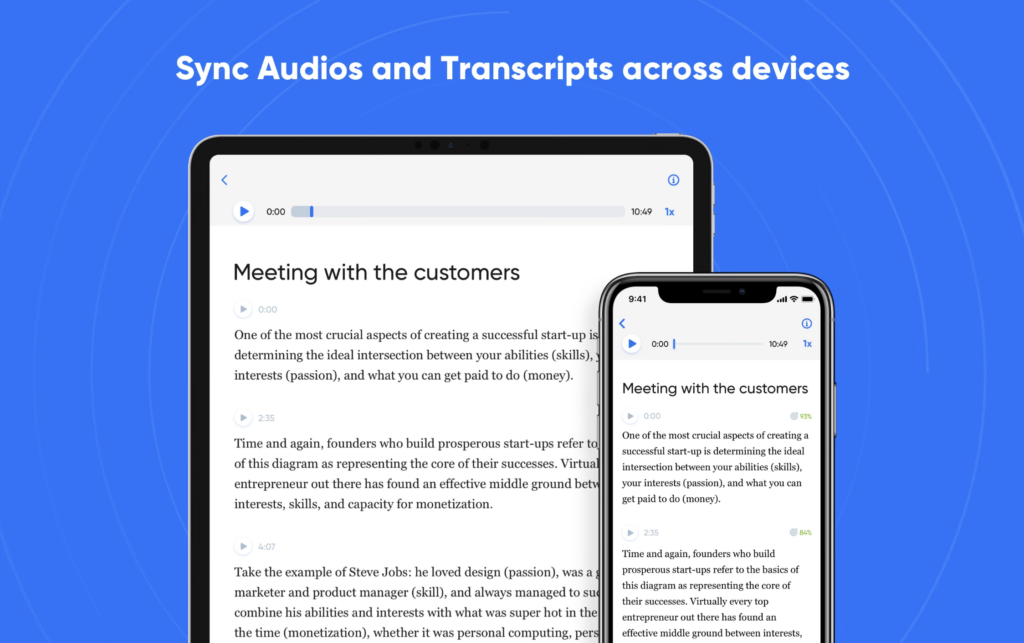
The Future of speech to text from audio file Software: A Look Ahead
Current State of Audio-to-Text Translation
Today, numerous programs and applications offer speech to text audio file services, based on various machine learning and artificial intelligence algorithms. They are capable of processing audio files of various formats, recognizing speech in a multitude of languages, and converting it into written text with quite a high degree of accuracy.
However, there are problems yet to be solved. For instance, background noise and overlapping voices can hinder speech recognition. Also, many systems struggle with understanding context, irony, or sarcasm, which can lead to transcription errors.
The Future of Audio-to-Text Technology
The future of speech to text audio file technology appears promising. It is expected that more advanced machine learning algorithms will be developed, significantly improving the quality of transcription.
The refinement of technology will involve increasing the accuracy of speech recognition, understanding and interpreting accents and dialects, as well as improving the system’s ability to process audio files with numerous participants and background noises.
Possible Challenges and Issues
However, despite optimistic forecasts, serious challenges lie ahead. Issues of confidentiality and data security will be at the forefront. Future software must ensure reliable information protection and comply with legislative requirements in the field of personal data protection. This requires significant efforts in the field of cybersecurity and the ethical use of AI.
Conclusion
Looking to the future of speech to text from audio file technology shows that this is a promising and rapidly developing field. Speech to text from audio file software will improve, becoming more accurate and user-friendly. Despite potential challenges and difficulties, it is important to work on solving them so that the technology becomes even better and safer. Based on current trends, it can be assumed that the future in this area will be bright and promising.
Frequently Asked Questions about the Impact of Audio-to-Text Translation Technology on Business and Everyday Life
Question: What is “speech to text from audio file”?
Question: How can “audio speech to text” change business?
Question: How can “speech to text audio file” change everyday life?
Question: What tools are there for “online speech to text from audio file”?
Question: What are the disadvantages of “speech to text from audio file”?
Question: What is “speech to text from audio file” and how does it work?
Question: What future trends can be expected in the field of “audio speech to text”?
Conclusion and Summary: The Impact of Audio-to-Text Translation on Business and Everyday Life
In conclusion, it can be said that the technology of audio-to-text translation is already bringing significant changes to business and everyday life. More than ever, audio-to-text translation tools are facilitating work, improving communications, and opening new possibilities for individual and collective use.
The ability to transform audio into text in real time opens doors for global communication, education, and business communication. It eases language barriers and accessibility, making the world a bit more connected. Meanwhile, with the growth of artificial intelligence and machine learning technologies, the future of these tools looks even more promising.
At the same time, it’s important to remember the privacy and security issues that also arise with the development of these technologies. Responsible use and processing of data, including audio data, must remain an important part of the discussion about the future of audio-to-text translation.
In conclusion, in a world where data is becoming an increasingly valuable asset, the ability to quickly and efficiently transform audio into text is a key tool for success in the 21st century. Whether it’s accelerating the workflow, increasing the accessibility of information, or breaking down language barriers, audio-to-text translation brings significant benefits for business and everyday life.
Are you ready to be part of the audio-to-text translation revolution? Join thousands of satisfied SpeechFlow users and transform your workflow. Click here to sign up and start using our innovative service.





